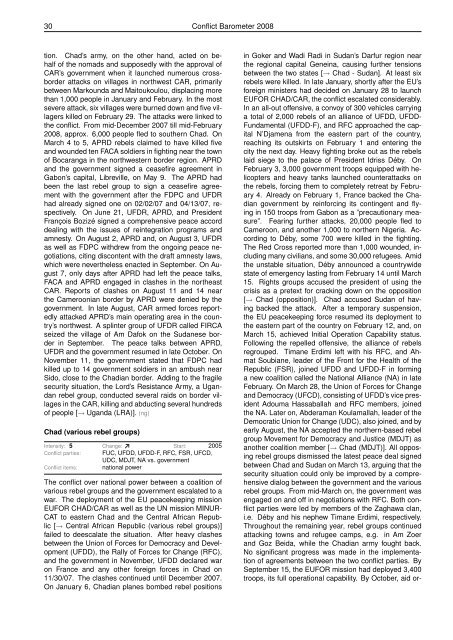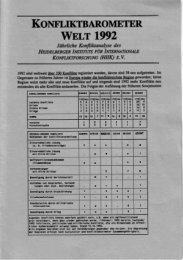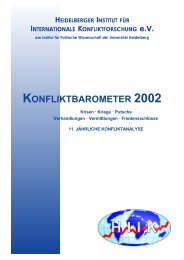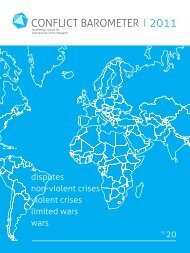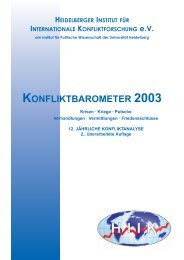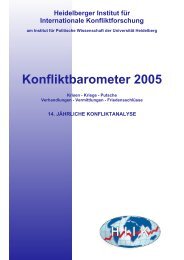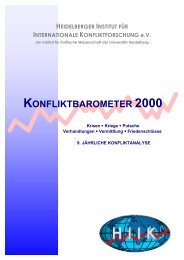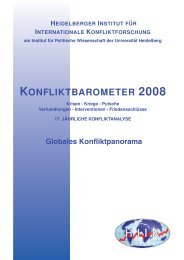CONFLICT BAROMETER 2008
CONFLICT BAROMETER 2008
CONFLICT BAROMETER 2008
Create successful ePaper yourself
Turn your PDF publications into a flip-book with our unique Google optimized e-Paper software.
30 Conflict Barometer <strong>2008</strong><br />
tion. Chad’s army, on the other hand, acted on behalf<br />
of the nomads and supposedly with the approval of<br />
CAR’s government when it launched numerous crossborder<br />
attacks on villages in northwest CAR, primarily<br />
between Markounda and Maitoukoulou, displacing more<br />
than 1,000 people in January and February. In the most<br />
severe attack, six villages were burned down and five villagers<br />
killed on February 29. The attacks were linked to<br />
the conflict. From mid-December 2007 till mid-February<br />
<strong>2008</strong>, approx. 6,000 people fled to southern Chad. On<br />
March 4 to 5, APRD rebels claimed to have killed five<br />
and wounded ten FACA soldiers in fighting near the town<br />
of Bocaranga in the northwestern border region. APRD<br />
and the government signed a ceasefire agreement in<br />
Gabon’s capital, Libreville, on May 9. The APRD had<br />
been the last rebel group to sign a ceasefire agreement<br />
with the government after the FDPC and UFDR<br />
had already signed one on 02/02/07 and 04/13/07, respectively.<br />
On June 21, UFDR, APRD, and President<br />
François Bozizé signed a comprehensive peace accord<br />
dealing with the issues of reintegration programs and<br />
amnesty. On August 2, APRD and, on August 3, UFDR<br />
as well as FDPC withdrew from the ongoing peace negotiations,<br />
citing discontent with the draft amnesty laws,<br />
which were nevertheless enacted in September. On August<br />
7, only days after APRD had left the peace talks,<br />
FACA and APRD engaged in clashes in the northeast<br />
CAR. Reports of clashes on August 11 and 14 near<br />
the Cameroonian border by APRD were denied by the<br />
government. In late August, CAR armed forces reportedly<br />
attacked APRD’s main operating area in the country’s<br />
northwest. A splinter group of UFDR called FIRCA<br />
seized the village of Am Dafok on the Sudanese border<br />
in September. The peace talks between APRD,<br />
UFDR and the government resumed in late October. On<br />
November 11, the government stated that FDPC had<br />
killed up to 14 government soldiers in an ambush near<br />
Sido, close to the Chadian border. Adding to the fragile<br />
security situation, the Lord’s Resistance Army, a Ugandan<br />
rebel group, conducted several raids on border villages<br />
in the CAR, killing and abducting several hundreds<br />
of people [→ Uganda (LRA)]. (ng)<br />
Chad (various rebel groups)<br />
Intensity: 5 Change: Start: 2005<br />
Conflict parties: FUC, UFDD, UFDD-F, RFC, FSR, UFCD,<br />
UDC, MDJT, NA vs. government<br />
Conflict items: national power<br />
The conflict over national power between a coalition of<br />
various rebel groups and the government escalated to a<br />
war. The deployment of the EU peacekeeping mission<br />
EUFOR CHAD/CAR as well as the UN mission MINUR-<br />
CAT to eastern Chad and the Central African Republic<br />
[→ Central African Republic (various rebel groups)]<br />
failed to deescalate the situation. After heavy clashes<br />
between the Union of Forces for Democracy and Development<br />
(UFDD), the Rally of Forces for Change (RFC),<br />
and the government in November, UFDD declared war<br />
on France and any other foreign forces in Chad on<br />
11/30/07. The clashes continued until December 2007.<br />
On January 6, Chadian planes bombed rebel positions<br />
in Goker and Wadi Radi in Sudan’s Darfur region near<br />
the regional capital Geneina, causing further tensions<br />
between the two states [→ Chad - Sudan]. At least six<br />
rebels were killed. In late January, shortly after the EU’s<br />
foreign ministers had decided on January 28 to launch<br />
EUFOR CHAD/CAR, the conflict escalated considerably.<br />
In an all-out offensive, a convoy of 300 vehicles carrying<br />
a total of 2,000 rebels of an alliance of UFDD, UFDD-<br />
Fundamental (UFDD-F), and RFC approached the capital<br />
N’Djamena from the eastern part of the country,<br />
reaching its outskirts on February 1 and entering the<br />
city the next day. Heavy fighting broke out as the rebels<br />
laid siege to the palace of President Idriss Déby. On<br />
February 3, 3,000 government troops equipped with helicopters<br />
and heavy tanks launched counterattacks on<br />
the rebels, forcing them to completely retreat by February<br />
4. Already on February 1, France backed the Chadian<br />
government by reinforcing its contingent and flying<br />
in 150 troops from Gabon as a ”precautionary measure”.<br />
Fearing further attacks, 20,000 people fled to<br />
Cameroon, and another 1,000 to northern Nigeria. According<br />
to Déby, some 700 were killed in the fighting.<br />
The Red Cross reported more than 1,000 wounded, including<br />
many civilians, and some 30,000 refugees. Amid<br />
the unstable situation, Déby announced a countrywide<br />
state of emergency lasting from February 14 until March<br />
15. Rights groups accused the president of using the<br />
crisis as a pretext for cracking down on the opposition<br />
[→ Chad (opposition)]. Chad accused Sudan of having<br />
backed the attack. After a temporary suspension,<br />
the EU peacekeeping force resumed its deployment to<br />
the eastern part of the country on February 12, and, on<br />
March 15, achieved Initial Operation Capability status.<br />
Following the repelled offensive, the alliance of rebels<br />
regrouped. Timane Erdimi left with his RFC, and Ahmat<br />
Soubiane, leader of the Front for the Health of the<br />
Republic (FSR), joined UFDD and UFDD-F in forming<br />
a new coalition called the National Alliance (NA) in late<br />
February. On March 28, the Union of Forces for Change<br />
and Democracy (UFCD), consisting of UFDD’s vice president<br />
Adouma Hassaballah and RFC members, joined<br />
the NA. Later on, Abderaman Koulamallah, leader of the<br />
Democratic Union for Change (UDC), also joined, and by<br />
early August, the NA accepted the northern-based rebel<br />
group Movement for Democracy and Justice (MDJT) as<br />
another coalition member [→ Chad (MDJT)]. All opposing<br />
rebel groups dismissed the latest peace deal signed<br />
between Chad and Sudan on March 13, arguing that the<br />
security situation could only be improved by a comprehensive<br />
dialog between the government and the various<br />
rebel groups. From mid-March on, the government was<br />
engaged on and off in negotiations with RFC. Both conflict<br />
parties were led by members of the Zaghawa clan,<br />
i.e. Déby and his nephew Timane Erdimi, respectively.<br />
Throughout the remaining year, rebel groups continued<br />
attacking towns and refugee camps, e.g. in Am Zoer<br />
and Goz Beida, while the Chadian army fought back.<br />
No significant progress was made in the implementation<br />
of agreements between the two conflict parties. By<br />
September 15, the EUFOR mission had deployed 3,400<br />
troops, its full operational capability. By October, aid or-


